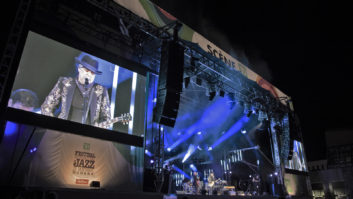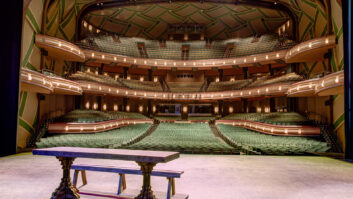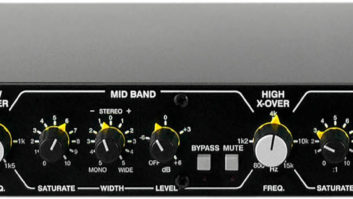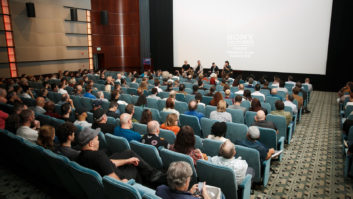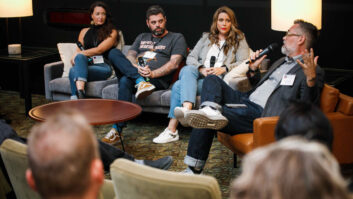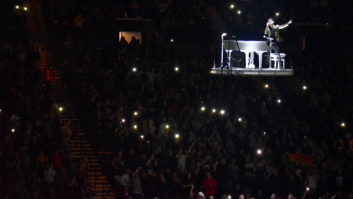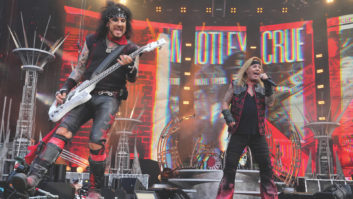Photo: Richard Battaglia
Béla Fleck doesn’t seem to know how to rest. When The Flecktones, his normal touring band, decided to take a break in 2005, banjo-picker Fleck originally thought he would lay low and play a few shows with friend Edgar Meyer. Instead, he has spent much of the year touring with two different trios, which he refers to as Trio! and the Béla Fleck Acoustic Trio. The Acoustic Trio — which includes Fleck, fiddler Casey Driessen and guitarist Bryan Sutton — played several festivals, including the Telluride Bluegrass festival (Telluride, Colo.) and Rocky Grass (Lyons, Colo.). Trio! — Fleck, bassist Stanley Clarke and fiddler Jean-Luc Ponty — has spent much of the latter-half of the year on the road playing improvisational jazz that often features all three solo’ing simultaneously.
When Fleck looked at going on the road with Trio!, he quickly found support from Flecktones sound engineer Richard Battaglia. “I’ve been doing sound since I started playing music in 1968,” says Battaglia. “I was a bass player and had a big bass amp, therefore the biggest car, so I had to carry the P.A., too. After I got out of college, I started working at a bar called the Down Yonder Saloon, and all these acoustic-style national acts like New Grass Revival came through. I became friends with them. In 1982, they needed a new sound person and I took on the job. Béla had been in New Grass for a year at that point. After New Grass Revival, I followed Béla through the weeds! New Grass Revival did their last show on December 31, 1989, opening for the Grateful Dead. About three months later, The Flecktones started touring and I went out with them.”
On this tour, Trio! is keeping their road gear light. That means Battaglia is working with house consoles at every venue. “I usually ask for a Midas, but I don’t always get it,” he says. “I like most of the Midas boards. There are only 12 channels for this tour, so it’s hard to ask for 56 when you aren’t using them.”
Monitor engineer Zach Newton was brought in from The Flecktones’ camp.
Photo: Candace Horgan
However, to keep some consistency in the sound, Battaglia carries his own effects. “I have a BSS DPR 404 4-channel compressor on the electric bass and the violin. I’ve also got a BBE 882 Sonic Maximizer, a TC Electronic Finalizer 96k across my left and right mains, and a Lexicon PCM 90 and 70 reverb. Here in Denver [where Mix caught up with the tour in mid-August], I’m only using the 90. I am also carrying an Avalon VT737 tube preamp/compressor EQ. I use it on Stanley’s bass to make it more consistent; it will give me the same control every night.
“I also carry the Ashly Protea,” he continues. “I have a little Palm Pilot that lets me EQ during soundcheck. I’m about to move up to the Lake Technology system — a wireless PC tablet. I don’t know if I will have it for this tour, but I’m hoping to have it by October. The Palm Pilot system is called Handycurve. It’s a MIDI controller that controls the Ashly EQs. It gets wired into the Ashlys and I can walk around and EQ the room. The Lake system will let me do that during the show. That is another way I can be consistent since I use local P.A.s and boards.”
Battaglia also likes to do a little analysis of the room and the P.A. “I use a program called SpectraFoo Complete. I use a Metric Halo Mobile I/O 2882 DSP for my interface via FireWire to my laptop, which runs SpectraFoo. I use it for a transfer function, and I can put meters on my solo output so I can see what each instrument looks like when I solo it. I use it every night — can’t live without it — and since I’m a Mac guy, I’m proud to use SpectraFoo.”
Although all the music is instrumental, each musician has a Shure SM58 to address the audience. Fleck has a Shure SM98 in the banjo and a Fishman Rare Earth pickup. He keeps a Klark-Teknik 10-band equalizer onstage and sends separate signals (mic and pickup) to Battaglia at front of house, which runs into a Chard Stuff preamp. (See sidebar.) Fleck also has an Eventide Eclipse multi-effects unit. Ponty uses an LR Baggs Para DI and a Lexicon MPX-550 reverb, while Clarke runs through an EBS MicroBass II preamp into an SWR Super Redhead amp.
Mixing Trio! is fairly simple, Battaglia says. “The biggest thing is to make Stanley happy. He likes to judge what is going on through the P.A. from the stage. That’s the big trick. Stanley tells me on the mic what he is hearing and we go from there. After 10 shows, I figured out what he likes and doesn’t like. He likes to hear real high end on the strings. The low end rumbles too much for him onstage, so he likes to hear string noise. I’ve been working with Béla so long, he just lets me go with it, and for Jean-Luc, we always check to make sure his violin isn’t too piercing. It gets a little easier because it doesn’t take over the whole P.A. the way the bass does. Otherwise, it’s pretty simple. My goal is to make it sound as acoustic as it can with pickups.”
Front-of-house engineer Richard Battaglia— inventor of the Chard Stuff preamp
Photo: Candace Horgan
For monitors, Trio! also borrowed from The Flecktones, choosing Zach Newton. “I started working at a small club for about a year, and from there moved on to FOH duties with Col. Bruce Hampton & The Aquarium Rescue Unit. After the first H.O.R.D.E. [Horizons of Rock Developing East Coast] tour, I began working with Béla. My respect and love for Béla run deep; I would find it difficult to pass up an opportunity to work with him. Throw in Stanley and Jean-Luc, and it was a no-brainer.”
On this tour, all three musicians are using in-ear monitors. “Jean-Luc has a downstage wedge as well [he only uses one ear],” Newton says. “Béla is the only one getting a stereo mix, and he gets a straight-ahead mix with an image of the stage, violin left ear, bass in middle and banjo on the right. Stanley has almost no bass in his mono mix, with Jean-Luc and Béla in there at fairly even levels. Jean-Luc only uses one ear, and he has a lot of bass and a little banjo, with little to no violin.
“I am using the Shure PSM700 transmitters with Shure HW600s [hardwire] as backup. Béla and Jean-Luc use Sony earbuds and Stanley is using a pair of Bang & Olufsen A1 headphones. They are using consumer-type earbuds to allow for less isolation and more comfort. The ‘cheap’ headphone approach seems to help musicians that are wary about in-ears feel more comfortable.”
Candace Horgan is a freelance writer based in Denver.
The Other Side of Life
Besides doing sound for The Flecktones, Robert Battaglia invented the Chard Stuff preamp, a unit that lets a musician blend signals from a mic mounted on the instrument and a pickup. The AcH 104 was developed during the New Grass Revival days. “Pat Flynn of New Grass Revival had this tiny little box that took a mic and pickup and split it,” Battaglia says. “It was a simple box. That’s where the idea started. After going through a lot of nightmares with little jumper cables and batteries falling apart, I decided I needed to come up with one box that did it all and made it foolproof. There is a guy in Nashville who did the electronic design after I gave him the concept. I still make them. Sam Bush, Emmylou Harris, Béla, Mark Schatz, Edgar Meyer and more use them. I’ve got about 85 of them out there.”
— Candace Horgan
